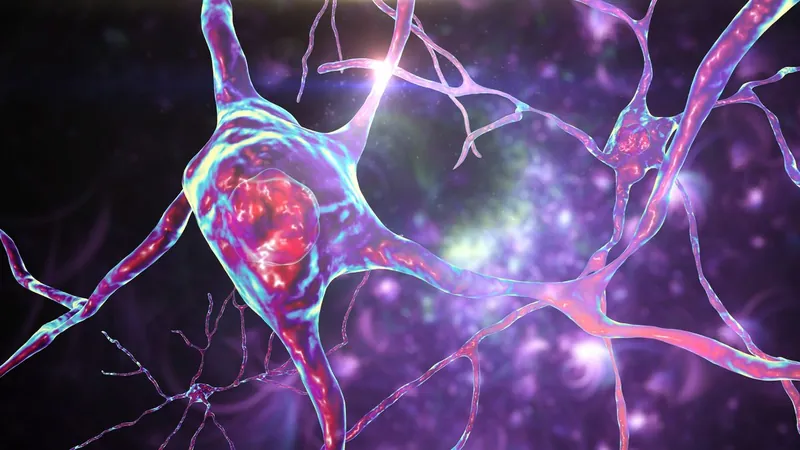
Breakthrough Discovery: Key Enzyme Uncovered as Potential Trigger for Huntington's Disease
2024-10-31
Author: Ming
Introduction
In an astonishing revelation, scientists have pinpointed an enzyme that may play a significant role in the onset of Huntington's disease, a rare and lethal neurodegenerative disorder characterized by the deterioration of brain cells. This groundbreaking research, recently published in the journal Nature Metabolism, offers hope for new preventative strategies against this devastating condition.
Key Findings
The study, which involved both human and rodent subjects, found that levels of an enzyme known as glutathione S-transferase omega 2 (GSTO2) increase in the brain before the emergence of Huntington's symptoms. This crucial finding could pave the way for novel treatments aimed at blocking GSTO2, effectively staving off the onset of the disease.
Understanding Huntington's Disease
Huntington's disease is an inherited condition arising from a mutation in the HTT gene, which encodes for the huntingtin protein. Individuals with this mutation carry a 50% chance of passing the disease to their offspring. The mutated gene causes an overproduction of dopamine—a vital neurotransmitter—resulting in the degeneration of neurons, particularly in the striatum. Symptoms typically manifest in a person's 30s to 50s and include severe cognitive impairments and involuntary movements. The progression of Huntington's disease is relentless, often leading to death within 10 to 30 years following symptom onset.
Challenges in Treatment
The exact reason for the excessive dopamine production due to the HTT mutation has remained elusive, explaining the absence of a cure for Huntington's disease. Current treatments only address symptoms after substantial damage occurs. Because the HTT gene is active throughout the body, creating targeted therapeutics that can counteract its effects in the brain has been a monumental challenge.
Innovative Research Approach
In this innovative study, researchers took a novel approach by examining the biochemical signals affected by the HTT mutation rather than focusing solely on the mutation itself. Professor Liliana Minichiello, the study's lead author, emphasized, "We explored the signals impacted by the mutation and their corresponding effects."
Neuronal Communication and Survival Signals
Neurons communicate through chemical signals, and proper signaling is essential for their survival and function. The research highlighted that survival signals are disrupted in Huntington's disease, particularly in striatal neurons that are most susceptible to these signaling failures.
Experimental Methodology
To delve deeper, the team created genetically modified mice lacking crucial survival signals in their striatal cells. Remarkably, they observed increased dopamine levels in these rodents' brains months before any movement-related symptoms appeared. The researchers linked the increased GSTO2 levels in these mice to the disruption of survival signals, suggesting that this cascade of events fueled dopamine overproduction and subsequent motor dysfunction.
Compelling Results
Moreover, parallel experiments revealed elevated GSTO2 levels in rats with conditions akin to Huntington's and in brain tissues from actual Huntington's patients—again, observed before any noticeable symptoms materialized.
Future Directions
These compelling findings illuminate critical cellular changes that could signal the beginning of Huntington's disease. The team now aims to investigate the GSTO2 role in mice carrying the HTT mutation to ascertain the causal relationship. If confirmed, GSTO2 could emerge as a promising target for drugs designed to prevent or slow the progression of Huntington's disease.
Conclusion
As researchers continue to unravel the complexities of Huntington's disease, this discovery serves as a beacon of hope for families affected by the condition, potentially directing future treatment approaches. Stay tuned for more updates as science pushes the boundaries of what we know about this debilitating disorder!




 Brasil (PT)
Brasil (PT)
 Canada (EN)
Canada (EN)
 Chile (ES)
Chile (ES)
 España (ES)
España (ES)
 France (FR)
France (FR)
 Hong Kong (EN)
Hong Kong (EN)
 Italia (IT)
Italia (IT)
 日本 (JA)
日本 (JA)
 Magyarország (HU)
Magyarország (HU)
 Norge (NO)
Norge (NO)
 Polska (PL)
Polska (PL)
 Schweiz (DE)
Schweiz (DE)
 Singapore (EN)
Singapore (EN)
 Sverige (SV)
Sverige (SV)
 Suomi (FI)
Suomi (FI)
 Türkiye (TR)
Türkiye (TR)